How to Check Dog Teeth, Mouth, and Gums
Your dog is your best friend, your partner in crime, and you want to do everything in your power to give them the best possible quality of life. Of course, this means keeping them active and feeding them high-quality food, but there is one health-related detail that is often overlooked – dental health!Not only can damaged dog teeth cause pain and discomfort for your dog, but they can also directly impact their overall health.Basic dog dental care starts at home with a simple exam of your dog’s teeth, mouth, and gums. This will allow you to identify any potential problems and address problems before they become something serious. The process is surprisingly easy when you (and your dog) get used to it!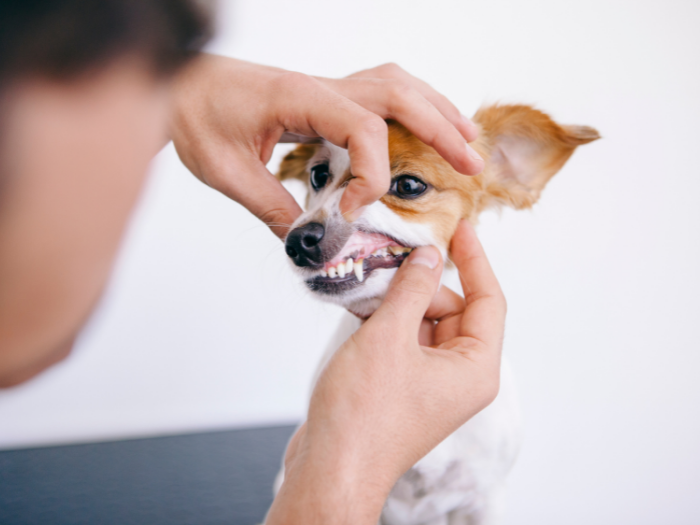
Preparing for Your Dog’s At Home Dental Health Exam
During your annual check-up, your veterinarian will do a dental exam to check on the condition of your dog’s teeth and gums, as well as any signs of injury or illness in or around their mouth. Your at home dental exam isn’t designed to replace that.Instead, this quick check will help you to stay on top of your dog’s oral health between appointments.To get started, you will need to gather up any supplies that you may need during this process. This will help you avoid stopping and starting your exam, making it even more stressful for your pup. This includes treats (or some other reward that your dog values), a flashlight if you are concerned about lighting, and a notepad to record your findings.If your dog is new to dental exams or gets easily stressed, you will want to find a calm, quiet place with low traffic and as few distractions as possible for the exam. In the beginning, take the exam slowly, and don’t be afraid to give your dog short breaks to relax and calm down, if needed.Each exam will get easier as your dog gets used to having you handling their mouth!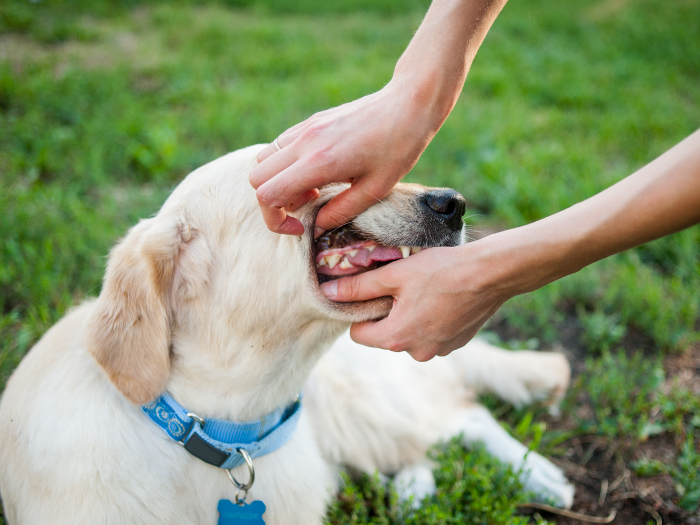
Checking Your Dog’s Teeth
Gently push the flap of your dog’s gums back and out of the way allowing you to look over your dog’s teeth. This will allow you to gain easier access to the canines in the front all the way to the molars at the back.
Discoloration
Dog teeth could be discolored for several reasons. If you notice any odd or abnormal coloring, it could be the result of staining by some ingredients in your dog’s food. However, the most common reason for a discolored tooth is damage to the tissue inside the tooth.If the pulp inside the tooth is damaged and starts to bleed, it may begin to die off. This causes the coloring of the pulp to change from pink to a darker purple, brown, or even gray. Damage to the pulp could be caused by blunt trauma to the teeth or jaw, biting down on something too hard, or damage to the tooth itself, like a crack.
Visible Plaque and Tartar Buildup
Just like with people, plaque occurs when the food particles from your dog’s meals mix with saliva and the bacteria present in their mouth creating a coating on their teeth. Within 24 hours, this plaque will then start to harden into tartar which can cause tooth decay, gum disease, and other dental health concerns. Significant plaque or tartar build-up will require a professional cleaning.
Chipping or Cracking
A small chip or crack in your dog’s teeth may not cause them any pain or discomfort, but it can quickly become something worse if not addressed. Take note of every crack, chip, or mark that you notice in your dog’s health log.You should also take the time to review any notes from previous checks to see if anything has changed. A growing crack, for example, is a clear indication that the situation is quickly getting worse, and you should contact your veterinarian as soon as possible.
Loose, Broken, or Missing Teeth
Broken dog teeth are often very painful and may even impact your dog’s ability to eat properly. To check this properly, you will want to gently touch your dog’s teeth to see if they move with the pressure. Loose, broken, and missing teeth need to be addressed quickly to relieve your dog’s pain and discomfort.
Bite Issues
Finally, take a moment to look at how your dog’s teeth come together when they bite down. Check for any change to their bite. To do this, you will have to first take notice of whether your dog regularly has an overbite, underbite, or any existing gaps in their bite. If any of this changes, it could indicate that there is something preventing them from biting down normally.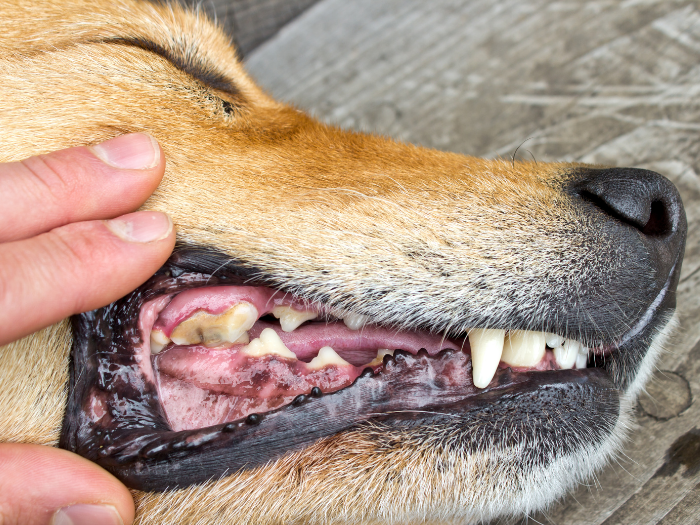
Checking Your Dog’s Gums
If you need to take a break to calm your dog down, this is a good time to do this. Take a moment to praise your dog for their patience and good behavior before moving on to looking at dog gums.
Discoloration
Healthy dog gums are naturally pink. However, any change to this coloring could indicate that something isn’t right. To take full advantage of this step, you will need to know your baseline, or your dog’s “normal” gum coloration, as it could differ slightly from dog to dog. Each time you check, compare the current color to this baseline.Some dogs will have black spots on their gums or tongue. These are similar to freckles on a human and aren’t a cause for concern.Pale dog gums could indicate a serious health concern such as kidney disease or anemia. On the other end of the scale, dark red gums could indicate irritation or infection. As these changes could be linked to a serious problem, it is advised that you talk to your veterinarian as soon as possible about any concerns relating to the color of your dog’s gums.
Receding Gumline
Look closely at the gumline, where the gum ends and your view of your dog’s tooth begins. If you notice that your dog’s gums appear to be pulling back from their teeth, this could indicate gingivitis.
Bleeding
As another early warning sign of gingivitis or other oral health concerns, bleeding is a sign of inflammation or irritation in the gums. This will often get worse if your dog is chewing on something, so take note of any signs of blood on toys or dog chews between your monthly exams.
Discharge
If there is any discharge other than bleeding, this is definitely a warning sign that something is wrong. This happens most often in situations where serious infection is present.
Lumps or Swelling
Run your finger gently along your dog’s gumline to feel for any lumps, bumps, or swelling. This could include soft tissue lumps, ulcers, swelling from gingivitis, or any other noticeable marks in this area of your dog’s mouth.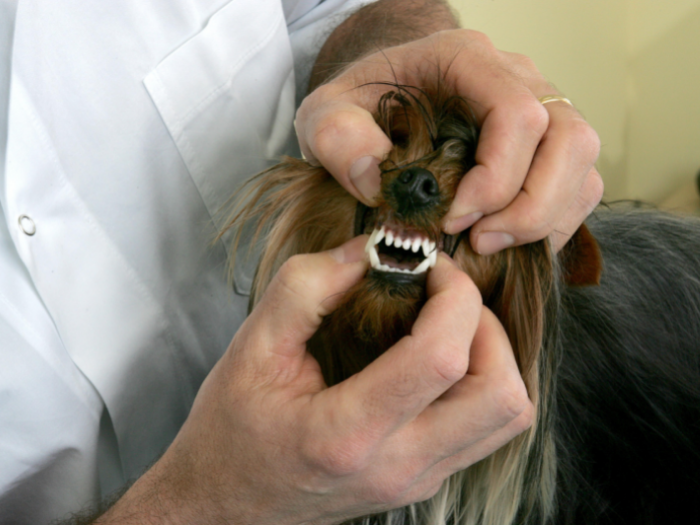
Checking Your Dog’s Mouth
The last phase of your dog’s at home dental examination is to look at the dog mouth as a whole, both inside the mouth and around the outside. This is your opportunity to note anything in or around your dog’s mouth outside of the teeth and gums.
Smell
As dog parents, we’ve all joked about that all too pleasant dog breath, but there does come a point where your dog’s stinky breath isn’t just an annoyance. Bad breath could be a warning sign of dental problems, diabetes, kidney issues, respiratory infections, liver disease, or other internal issues.
Cuts or Abrasions
Look for any signs of cuts or abrasions inside or around the exterior of your dog’s mouth. While the cause could be something as simple as your dog chewing on a stick in your yard, scratching the roof of their mouth, you will want to monitor any cuts or scrapes carefully. With food particles, saliva, and bacteria all moving throughout your dog’s mouth, even minor scrapes can easily become infected.
Sensitivity
Just as you would do with a full dog body scan, take a moment to run your hands along the outside of your dog’s mouth and down the jawline to their neck. Did your dog pull back or appear uncomfortable at any point in this process?Pain or sensitivity could reveal a problem that can’t be seen to the naked eye, requiring a more in-depth exam by your veterinarian.
Swelling
Like sensitivity, swelling in and around your dog’s mouth could reveal a problem that you were unable to see while doing the rest of your exam.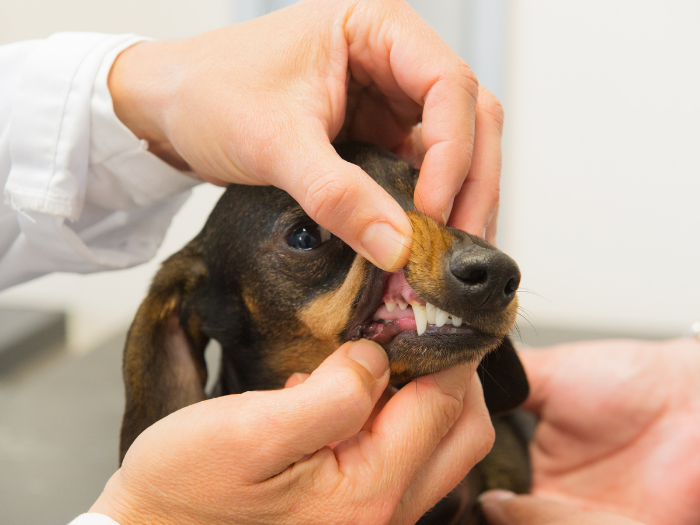
Continuing Your Dog’s At Home Care
Congratulations on completing your first at home dental exam! By checking your dog’s teeth, gums, and mouth, recording any observations, you are taking an important step forward in terms of prioritizing your dog’s health.By combining your notes from your at home dental exam with the other 4 health checks in the Pet Health 5 movement – Body Scan, Temperature, Weight, and Heart Rate, you can identify any problems early while also assisting your veterinarian by providing a bigger picture of your dog’s health over time.In addition to doing your monthly at home dental exam, you can also help to improve your dog’s dental health with products designed to clean away the plaque and tartar including dental chews and treats, dental toys, water additives, and, of course, brushing your dog’s teeth.What steps do you currently take to help keep your dog’s teeth looking clean and healthy?Your dog’s dental health is one of the five vital states that we encourage all dog parents to monitor. Are you interested in learning more about how to make your dog’s health a priority?Join us in our Pet Health 5 movement and together we can start tracking our dog’s health. It’s super easy! Each month, on the 5th, we’ll send you a reminder with a checklist of what to do and how to do it. All you need to do is take the time to check your dog’s health stats and log them.Pet health and dog health is an important aspect of helping our dogs live long and happy lives. You can start today by checking your dog’s teeth, mouth, and gums, and signing up for Pet Health 5.
About the Author: Britt Kascjak is a proud pet mom, sharing her heart (and her home) with her "pack" which includes her husband John, their 3 dogs - Daviana, Indiana, and Lucifer - and their 2 cats - Pippen and Jinx. She has been active in the animal rescue community for over 15 years, volunteering, fostering and advocating for organizations across Canada and the US. In her free time, she enjoys traveling around the country camping, hiking, and canoeing with her pets.